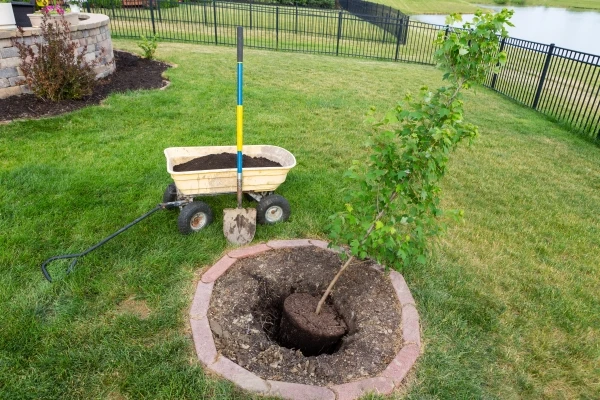
The Grounds Guys highlight optimal timing and tips for tree planting and transplanting in Canada.
|
They’re aesthetic, shady, and some have fresh-smelling blossoms – trees simply bring a wonderful atmosphere to the yard. But before going out and planting or transplanting a tree, plan ahead for the best time to plant, make sure you have the new space ready, and have everything you need to make the planting or transplanting successful.
Related Topic: Best Trees for the Front Yard
Best Time to Transplant Trees
The ideal time to transplant is when the tree is still dormant. Normally this would be late fall, after the last leaf has dropped but before the ground is frozen, or early spring before the new buds form. If you are transplanting trees in spring, expect the growth to be stunted for that season.
How to Dig a Tree for Transplanting
- Locate the New Spot: Carefully consider the space you plan to relocate the tree. Check if there are wires overhead that the tree may grow into in the future. And find out if there are utility lines in the way of the roots by contacting Dig Safe Canada before you start.
- Get Your Measurements: The root ball is the ball of dirt that you will carry along with the roots to the new hole. To find how wide you should dig to cover all the roots, measure the trunk diameter. Calculate 30 to 45 centimetres for the diameter of the roots for every three centimetres of the trunk’s diameter.
Trees with diameters over five centimetres will take heavy-duty equipment to dig up and move. For these larger trees, be safe and call an expert, like your trusted Grounds Guys, to help with the transplant.
- Water Generously Before Digging: A day or two before you plan to move the tree, give it heavy water. This will soften the soil and make it easier to dig through.
- Tie the Branches: Secure the branches to protect them during the move, but also to keep them from whipping you while you work with the tree.
- Prepare the New Hole: Before you break ground in moving the tree, you will want to dig the new hole and have it ready to receive the tree. You already have your measurements for the size of the hole from your calculations for the root ball, and you’ve ensured there are no utility lines in the way.
- Trench Around the Roots: Using your calculations for the roots, take a sharp spade shovel and start around the edge of what will be the root ball. Dig down 30 to 60 centimetres before cutting under the roots to round out the ball.
- Transport the Tree: The tree is very vulnerable at this time, and you will need to take extreme care. If you have an extra set of hands available, you will want the help here. The dirt around the roots has to stay well intact, or else the tree may not survive the process. Cut a piece of burlap that is large enough to hold the root ball. Tipping the ball to one side, slide the burlap in the hole and roll the roots into it. Using twine, make sure the roots are secure. When you are ready to lift the tree, make sure to lift from the bottom rather than the trunk, which could cause damage. Gently carry the tree to its new home.
- Plant the Tree: Carefully place the tree in the new hole. The top of the root ball should be just above ground level, but no more than three to five centimetres. When you have the tree fit where you want it, you can cut and remove the twine and burlap. Then fill the hole with soil from the tree’s original location.
- Protect from Transplant Shock: The process of transplanting may be over, but your tree will still need time to heal. With extra care, you can help it along.
But before you grab a fertilizer for transplanted trees, evaluate first if your tree needs to be fertilized. Because trees and shrubs don’t benefit from overfertilization, it’s better to wait until your tree has been established for a full growing season before offering it fertilizer.
Another option while your tree is getting settled is to apply mulch. Mulch prevents weeds, minimizes loss of water to evaporation, insulates the roots from extreme temperatures, and breaks down to offer the soil nutrients. Using an organic woodchip mulch two to five centimetres from the trunk, you can offer nutrients back to the soil for the tree to absorb. (Applying too close or covering the base of the trunk can smother the tree.)
Related Topic: Protecting Trees from Deer
Move Trees with Your Trusted Grounds Guys
Trees are a beautiful addition to your yard but planting new trees or moving existing trees can be a big, time-consuming project. And if not done correctly and with care, you run the risk that the tree may not survive the move. If you have trees you would like to move, or you want to plant new ones, your local landscaping pros at The Grounds Guys can help. We're experts at keeping your tees and the rest of your landscaping looking its best all year long. To learn more give us a call or request an estimate online for tree planting services you can trust.